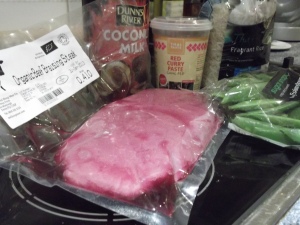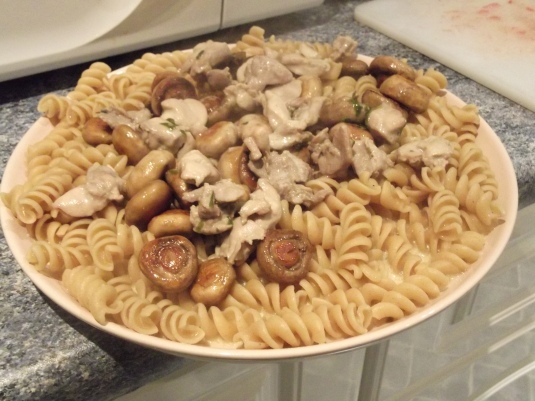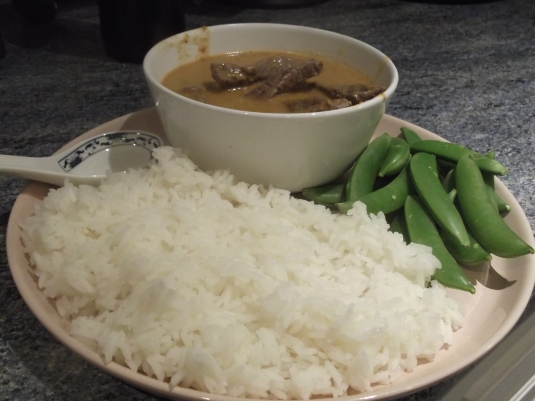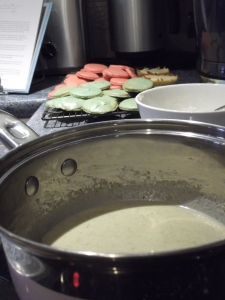One of Jamie Oliver’s successes has been in trying to get people to cook good food, healthily, in their day-to-day lives. Notably he’s made recipe books based on the concept of 30 minute meals and more recently 15 minute meals, which hope to give nobody the excuse that they are too busy to cook proper food. Starting from ingredients you might buy from a supermarket, you can do all of the cooking and have the meal ready in either 30 or 15 minutes, and there are a variety of recipes to keep meals interesting.
Whilst I agree with the sentiment- that nobody is too busy to cook properly, and we should be encouraged to make quick food over eating ready meals- I’m not sure I agree with the approach. I’m much more a fan of the slow food movement. Very few foods benefit from cooking quicker than you might otherwise, steak is the only one that comes to mind. Evolution has trained us to cook food slowly, to break down proteins and so reduce the cost of digestion. Many cultures in the world have key communities built around the cooking process, and I’ve often used cooking as a social event. Finally, slow food creates complexity in a dish, combining many flavours over a long cooking time, whereas cooking quickly rarely creates a dish that is anything more than the sum of its ingredients.
But slow food requires time and effort, you say. Time, yes, but effort? No. Most stews, and even more complicated dishes like cassoulet or confit, are little more effort than putting ingredients in a pot. The results are usually great, you often have leftovers that can be tomorrow’s dinner or put in the freezer, and stews don’t often matter whether you return to them after three hours or four. Even if you can’t be in the house for that long, you can use a slow cooker, or program the oven to turn itself off after a certain amount of time. So, if I’m giving advice on how to cook with minimal effort, it would be to slow cook.
However, recently Mrs. Oxfood challenged me with coming up with some proper 15 minute meals, rather than just meals that required fewer than 15 minutes of effort, so here they are. In coming up with the recipes, the first difficulty was ingredient preparation. Meals which have ingredients which require lots of peeling and chopping with naturally take a long time won’t fit under the 15 minutes mark, unless you are ruthlessly efficient. (My favourite example for this is onion soup. If you put “1kg onions, peeled and roughly chopped” on the ingredients list, the soup takes 5 minutes. If you put “1kg onions” on the list, the soup will take 30 minutes.) The second difficulty was reducing. Many stocks and sauces require reducing to thicken, and this takes time. To avoid this, I simply used stock cube and only put a small amount of water in: pre-reduced, in some sense. You do lose flavour development, but it is hard to do these dishes in 15 minutes otherwise.
The two dishes I made were flambéed chicken, and our easy thai curry. They’re among our day-to-day recipes, but contain few ingredients, can be adapted to whatever you have in your fridge, and can be sped up easily. We really like them, and they worked fine in the 15 minute version, but the dish just isn’t as good as when we make it normally. If I’m honestly recommending how to cook them, I would suggest you use longer on the sauce reductino to allow complexity to develop and flavours to mingle. I’ll say well done to Jamie Oliver for getting people to cook more day-to-day, but I think slow food is the way to do this, not fast food.
Flambéed Chicken
Just a note to be careful with the flambéeing part here. Think about how you are going to do it safely beforehand.
Ingredients:
200g dried pasta.
400g chicken breast (diced, if you can)
1 pot Tesco finest crème fraiche d’Isigny
2 tbsp dried tarragon
4 tbsp brandy
1 match
1 stock cube made up in 150ml water
olive oil for frying
Recipe:
1. Boil a kettle and get the pasta cooking.
2. Dice the chicken breast if you haven’t already and heat the oil in a large skillet/pan. Fry the chicken until browned.
3. Pour the brandy over the chicken and set on fire. Stir until the flames are put out.
4. Add the stock, crème fraiche and tarragon. Season the sauce. Over a high heat, stir while the mixture is reducing to the desired consistency. Drain the pasta, the pour sauce and chicken over it.
Easy Red Thai Curry
Ingredients:
1 can coconut milk
200g beef steak (diced if possible)
3 tbsp red thai curry pasty
150g rice
sugarsnap peas, to serve
Recipe:
1. In a pan, begin reducing the coconut milk. Boil a kettle and get the rice going.
2. Dice the beef if not already done. In another pan, fry the beef until brown. Add the beef and the thai curry mix to the coconut milk and reduce to the desired consistency.
3. Drain the rice, and serve.





